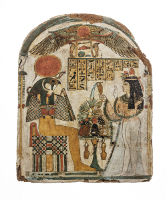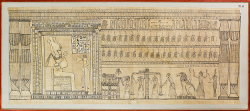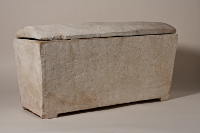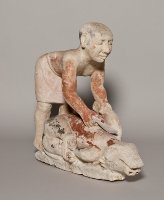Funerary Stela
Found in the Ramesseum at Thebes, this painted funerary stela was erected to commemorate the lady Djed-Khonsu-es-ankh. The deceased woman, in a diaphanous white gown, wears a cone of perfumed beeswax and a water lily on her head. She pours a libation over a table of food offerings and raises her hand to greet the seated god Re-Harakhty, a form of the ancient Egyptian sun god. The hieroglyphic signs offer a prayer asking the gods to supply food and drink for the survival of her spirit in the netherworld.
The inscription, a standard offering formula, reads:
An offering which the King gives to Re-Harakhty, the Great God, Lord of Heaven, that he may give invocation-offerings consisting of offerings and food to the Osiris, Lady of the House, the noblewoman, Djed-Khonsu-es-ankh, deceased, daughter of the priest of Amun-Ra, King of the Gods, Master of the Secrets of the Garments of the Gods, Ser- Djehuty.
Book of the Dead
The Book of the Dead was a collection of spells, hymns, and prayers intended to secure for the deceased safe passage to and sojourn in the other world. The sections of papyrus on display to the left and right are from one of these long scrolls, which was cut into fifteen sections in modern times.
The illustration to the left shows the judgement of the soul before Osiris, the god of the dead, who determines the deceased's worthiness to enter the next life by assessing his earthly deeds. The heart of Yartiuerow (the deceased) is being weighed in the balance against the feather of the goddess Maat, representing truth and justice. The jackal-god Anubis tips the balance in Yartiuerow's favor while the falcon-headed god Horus looks on and the ibis-headed Thoth, the secretary of the gods, records the favorable verdict. Yartiuerow himself stands on the right, his hands raised in jubilation, accompanied by the goddess Maat. Before him is a monster-part hippopotamus, part crocodile, and part lion- which would have annihilated him had the judgement been unfavorable.
The title of the Book of the Dead and its method of use are stated in the horizontal line at the top of the section exhibited to the right: "Beginning of the spells for going forth by day which raise the glorious ones (i.e., the dead) in the cemetery. To be said on the day of burial of entering in after going forth, by Osiris Yartiuerow, deceased." The vignette below shows part of the funeral procession. The sledge bearing the coffin is drawn by oxen. Two smaller sledges, each drawn by a man, follow. The one behind the coffcin bears the canopic box containing the four jars in which the viscera were preserved. On its lid lies a figure of the mortuary god Anubis in jackal form.
Mummy Mask
Mummy masks were a traditional part of the funerary equipment with which ancient Egyptians supplied their burials for the life they believed would continue after death. This example is a stylized portrait of the deceased, evidently a woman. It originally covered the head and shoulders of her mummified body.
The medium is cartonnage, a kind of ancient Egyptian papier- mache made from used linen and papyrus. The cartonnage was coated with gesso before the paint and gilding were applied.
The deceased is shown wearing a necklace at the throat with a heart amulet as a pendant. Below is a broad collar necklace fringed with drop pendants.
A representation of funerary shrines with double doors appears on each shoulder. The god Osiris sits on top of each shrine. These divine figures were intended to represent the deceased after death, for it was believed that all were reborn as Osiris. The feather which the god holds is an allusion to the deceased successfully being reborn after passing a judgement before the tribunal of the gods.
Coffin of Ipi-Ha-Ishutef
A man named Ipi-ha-ishutef commissioned this coffin and had it decorated with inscriptions and pictures designed to assist him in the afterlife.
The interior of the lid contains spells from the Pyramid Texts to protect the deceased from harm and to facilitate his passage to the netherworld. These texts had been carved on the walls and corridors of royal tombs beginning toward the end of the Old Kingdom (ca. 2755-2213 B.C.). Later, as here, they came to be used by non-royal persons as well and are then known as Coffin Texts.
The eyes painted at the head end of the coffin were positioned opposite the eyes of the deceased as he lay within on his left side. These 'Eyes of Horus' provided him with a magical means of looking out.
Inside the coffin, behind the eyes, is a painted doorway through which the soul of the deceased might pass to visit the outer world. The remainder of the coffin's interior bears representations of items that the deceased had used on earth and would need in the afterlife, such as food, drink, clothing, and weapons, as well as royal insignia, resting mostly on low stands.
This coffin was excavated near the pyramid of King Teti at Saqqara. Ipi-ha-ishutef's title was "Scribe and Overseer of the expedition [or army]."
Inscribed Ossuary
The name "Yo-ezer the scribe" is inscribed on one end of this ossuary, a repository for bones. Around the end of the 1st century B.C., Jewish burial practices changed from primary burial in wooden coffins to secondary burial in small limestone caskets such as this one. The body seems first to have been buried in a pit until only the bones remained. These were then gathered up and transferred to the ossuary, which was placed in a rock-hewn communal tomb.
This ossuary is decorated with incised geometric designs. The Hebrew inscription on the side reads "Yo-ezer, son of Yehohanan, the scribe."
Butcher Slaughtering a Calf
This statuette of a butcher is one of a group of sculptures placed in the tomb of an ancient Egyptian official so that he might take with him into the afterlife things that had been important to him during his lifetime. The group, which seems to represent the household and staff of a typical prosperous estate owner in Old Kingdom Egypt, included representations of the owner Ny-kau-Inpu and his family, two butchers, men and women processing grain and making bread, four musicians, a metalworker with a blowpipe, a potter, and even two children playing leapfrog.







